
A beehive is an enclosed structure where some honey bee species of the subgenus Apis live and raise their young. Though the word beehive is used to describe the nest of any bee colony, scientific and professional literature distinguishes nest from hive. Nest is used to discuss colonies that house themselves in natural or artificial cavities or are hanging and exposed. The term hive is used to describe an artificial/man-made structure to house a honey bee nest. Several species of Apis live in colonies. But for honey production, the western honey bee and the eastern honey bee are the main species kept in hives.
Beekeeping is the maintenance of bee colonies, commonly in artificial beehives. Honey bees in the genus Apis are the most commonly kept species but other honey producing bees such as Melipona stingless bees are also kept. Beekeepers keep bees to collect honey and other products of the hive: beeswax, propolis, bee pollen, and royal jelly. Other sources of beekeeping income include pollination of crops, raising queens, and production of package bees for sale. Bee hives are kept in an apiary or "bee yard".
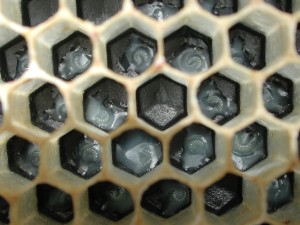
In beekeeping, bee brood or brood refers to the eggs, larvae and pupae of honeybees. The brood of Western honey bees develops within a bee hive. In man-made, removable frame hives, such as Langstroth hives, each frame which is mainly occupied by brood is called a brood frame. Brood frames usually have some pollen and nectar or honey in the upper corners of the frame. The rest of the brood frame cells may be empty or occupied by brood in various developmental stages. During the brood raising season, the bees may reuse the cells from which brood has emerged for additional brood or convert it to honey or pollen storage. Bees show remarkable flexibility in adapting cells to a use best suited for the hive's survival.

A queen bee is typically an adult, mated female (gyne) that lives in a colony or hive of honey bees. With fully developed reproductive organs, the queen is usually the mother of most, if not all, of the bees in the beehive. Queens are developed from larvae selected by worker bees and specially fed in order to become sexually mature. There is normally only one adult, mated queen in a hive, in which case the bees will usually follow and fiercely protect her.
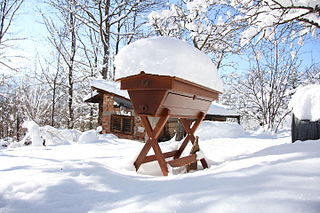
A top-bar hive is a single-story frameless beehive in which the comb hangs from removable bars. The bars form a continuous roof over the comb, whereas the frames in most current hives allow space for bees to move up or down between boxes. Hives that have frames or that use honey chambers in summer but which use management principles similar to those of regular top-bar hives are sometimes also referred to as top-bar hives. Top-bar hives are rectangular in shape and are typically more than twice as wide as multi-story framed hives commonly found in English-speaking countries. Top-bar hives usually include one box only, and allow for beekeeping methods that interfere very little with the colony. While conventional advice often recommends inspecting each colony each week during the warmer months, heavy work when full supers have to be lifted, some beekeepers fully inspect top-bar hives only once a year, and only one comb needs to be lifted at a time.
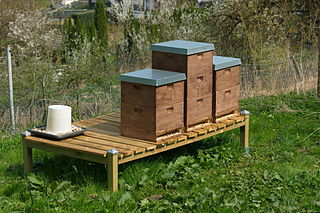
In beekeeping, a Langstroth hive is any vertically modular beehive that has the key features of vertically hung frames, a bottom board with entrance for the bees, boxes containing frames for brood and honey and an inner cover and top cap to provide weather protection. In a Langstroth hive, the bees build honeycomb into frames, which can be moved with ease. The frames are designed to prevent bees from attaching honeycombs where they would either connect adjacent frames, or connect frames to the walls of the hive. The movable frames allow the beekeeper to manage the bees in a way which was formerly impossible.
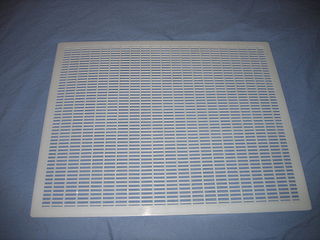
In beekeeping, a queen excluder is a selective barrier inside the beehive that allows worker bees but not the larger queens and drones to traverse the barrier. The bars have a distance of 4.2 millimeters. The barrier grid was probably invented around 1890.

A hive frame or honey frame is a structural element in a beehive that holds the honeycomb or brood comb within the hive enclosure or box. The hive frame is a key part of the modern movable-comb hive. It can be removed in order to inspect the bees for disease or to extract the excess honey.
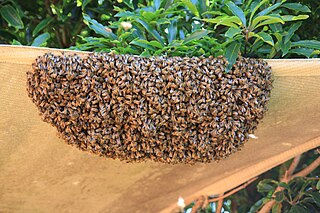
Swarming is a honey bee colony's natural means of reproduction. In the process of swarming, a single colony splits into two or more distinct colonies.

A honey extractor is a mechanical device used in the extraction of honey from honeycombs. A honey extractor extracts the honey from the honey comb without destroying the comb. Extractors work by centrifugal force. A drum or container holds a frame basket which spins, flinging the honey out. With this method the wax comb stays intact within the frame and can be reused by the bees.
Hive management in beekeeping refers to intervention techniques that a beekeeper may perform to ensure hive survival and to maximize hive production. Hive management techniques vary widely depending on the objectives.

A nuc, or nucleus colony, is a small honey bee colony created from larger colonies, packages, or captured swarms. A nuc hive is centered on a queen bee, the nucleus of the honey bee colony.

Petro Prokopovych was a Ukrainian beekeeper who made revolutionary contributions to the practice. They include the founding of commercial beekeeping and the invention of the first movable frame hive. He introduced novelties in traditional beekeeping that allowed great progress in the practice. Among his most important inventions was a hive frame in a separate honey chamber of his beehive. He also invented a crude queen excluder between brood and honey chambers. Petro Prokopovych was also the first to ever model a 'bee beard' after delineating and calculating 'bee swarm behaviour", inspiring students for generations.
In beekeeping, the Demaree method is a swarming prevention method. It was first published by George Demaree (1832–1915) in an article in the American Bee Journal in 1892. Demaree also described a swarm prevention method in 1884, but that was a two-hive system that is unrelated to modern "demareeing".

Charles Dadant was a French-American beekeeper. Along with Petro Prokopovych, Dadant is considered one of the founding fathers of modern beekeeping.

Honey extraction is the central process in beekeeping of removing honey from honeycomb so that it is isolated in a pure liquid form.

A Jenter kit or Karl Jenter kit is a piece of equipment used by beekeepers to raise large numbers of queen honeybees.

Thomas White Woodbury was an English journalist and beekeeper, devoting himself entirely to beekeeping from 1850 onwards after the death of his son. He was responsible for introducing Ligurian or Italian bees to Britain in 1859.
In 1859 Woodbury imported a yellow Ligurian queen from Mr Hermann in Switzerland. She arrived by train on 3 August in a rough deal box with about a thousand worker bees. Woodbury had prepared an 8-bar hive, including four frames of honey and pollen plus one empty comb, and he gently shook the newcomers into this. Then he took a skep of local black bees weighing 34.5 pounds and shook them out in clusters on four cloths spread out on the grass; helped by his friend Mr Fox. He found and took out the queen, before placing the hive with Ligurian queen and bees over the shaken bees. Alas they fought, and in the morning there were many dead bees, but he hoped for the best. By 17 August, great loads of pollen were going in, and he knew that the first queen from outside Britain had been introduced. When he wrote about this in the 'Cottage Gardener' he had letters from all over the country asking for stocks from this queen for next year, so at once he telegraphed for two more queens and they arrived on 27 August having been four days on the way. Although most of the bees were dead, each package had their queen still living, and each queen was successfully introduced to a colony. Ron Brown Great Masters of Beekeeping
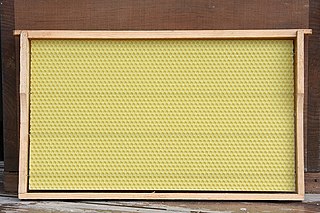
Wax foundation or honeycomb base is a plate made of wax forming the base of one honeycomb. It is used in beekeeping to give the bees a foundation on which they can build the honeycomb. Wax foundation is considered one of the most important inventions in modern beekeeping.
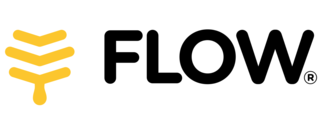
Flow Hive is a brand of beehive with a unique honey frame, which allows honey extraction without opening the beehive. During extraction, bees are visibly disturbed less than by other methods.
















